How to make a coil pot is a standard practice in many art rooms, but for me, I held off teaching them for over six years. For some reason, they scared the dickens out of me. I had seen far too many elaborate coil pots photographs that I couldn’t imagine my students completing a project of this scale in the time period that I had. My concerns were justified because coil pots can take some time to complete. If you are new to ceramics or don’t have a kiln and you don’t have much time with your students, here are a few tricks to ensure coil pots make your art project list.
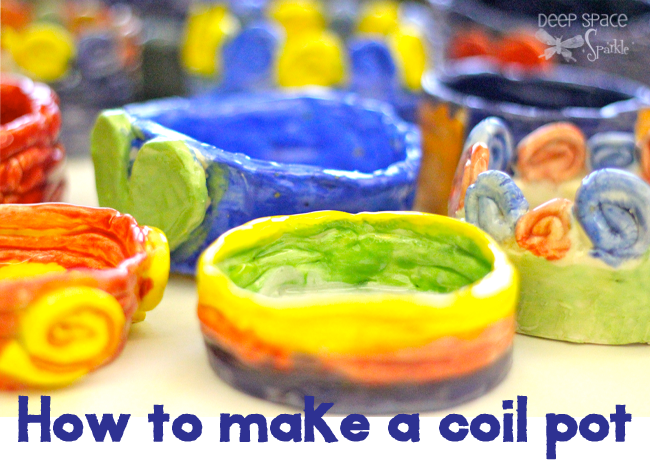
Tip #1
Keep your expectations low. You will not be making this:
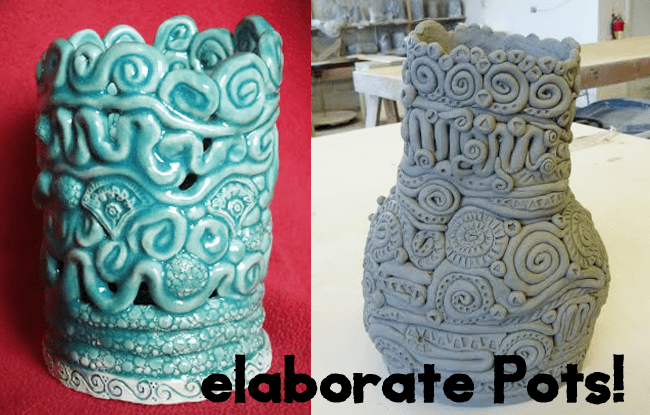
(Credits: Left Tia Made, right Pippi’s Jewelry)
Of course, you could, but they take some serious time. Instead, we will attempt to make a pot that requires only two, 50-minute sessions.
Building the Coil Pots
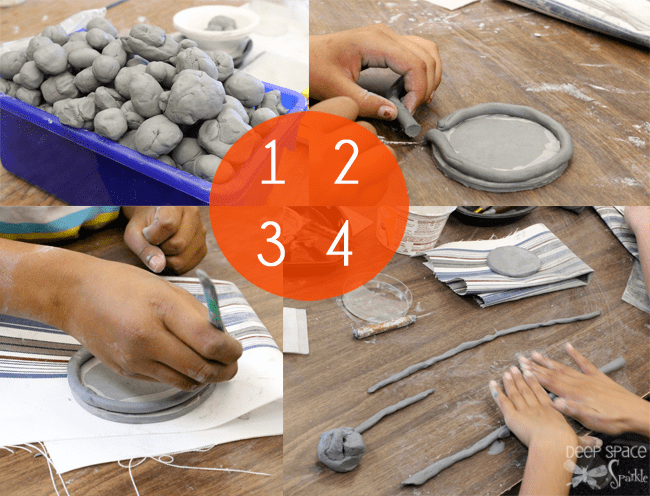
1. This is a great project to do towards the end of a ceramic unit when you have a bunch of clay balls. I keep my clay balls in the original clay bag and add a sprinkling of water every now and then to keep the clay moist. Give each child a few balls of clay and 1 tile of clay.
2. Use a plastic container cover to trace a circle from the flat piece of clay. This will be the base of the clay pot. Peel away excess clay and keep for “ropes”.
3. See how the ropes are placed around the round bottom? To make sure they stick, use a mixture of clay bits, water and a splash of vinegar to make a “slip”. The vinegar adds some stickiness to the slip and also aids in the breakdown of the clay. Demonstrate how to brush a bit of slip onto the flat base, place rope on top and brush rope with some slip. It’s just like adding wet sand to a sand castle. Holds everything together.
4. How to make ropes: This is by far one of the more challenging ceramic techniques for kids in my opinion. It’s very hard to keep the ropes even in size, so make sure not to set up an unrealistic expectation by demonstrating perfect rope-making yourself. Keep it a bit sloppy then the kids will not be so hard on themselves.
Here’s what I do:
Place a ball of clay between your palms and roll back and forth until you have a piece of clay the size of a small sausage. Place “sausage” on mat/table and gentle push the sausage back and forth until it starts thinning out. The trick is to gently slide hands outwards as you roll. This extends the rope. Tell the kids they do not have to make skinny ropes: any size will do but the rope should be long enough to wrap around the base.
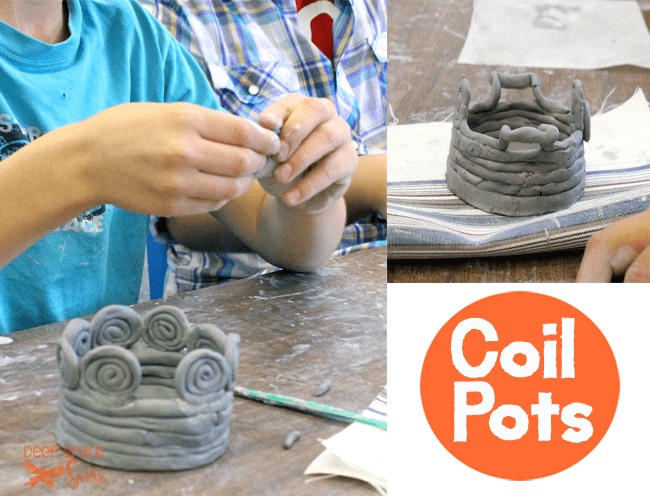
Tip #2
After about five ropes are stacked and “glued” to the base, the children can start making decorative scrolls. Anymore “stacks” and time will start to run out. The goal here is to complete the pot in under 50-minutes which includes the demo, so there is not a lot of time to go crazy with the stacking.
Some kids will want to add handles, etc. All good except they sometimes forget to use the slip. My theory is that they just get too excited with the decorative elements, they forget the “rules”. Go around and remind them or else you will have a hundred little pieces of clay at the bottom of your kiln.
Finishing Up & Drying:
Once the 50-minutes are up, make sure each child etches his name on the underside of the pot. Bring to a table and allow to dry for a week to ten days. You can see that many of my students pots are incomplete. I really try hard to encourage the kids to work at a steady pace so they can finish the pot. They know that they only have a certain amount of time, because they experienced this the last time they did ceramics with me. I’m consistent with the time-frame so most kids know that when the time is up, its up.
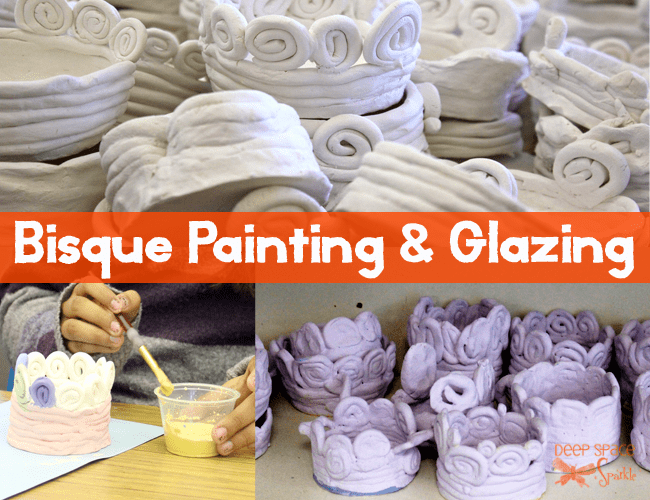
After a week or so, the bisque should be ready to place in the kiln. Follow the clay instructions for firing. After the pots cool down, the kids can paint them. Here are a few options:
- Paint with underglaze then dip or brush on glaze (shown above), then fire once more. This is what I do as I have underglaze and I love how it looks.
- Paint with acrylic paints and send the project home (just one firing!)
- Paint with watercolor paints and add a glossy coat of Mod-Podge or Spray Acrylic.
What to do when a child misses this session:
This always happens, so don’t complain and begrudge the kid’s lack of attendance. Simply prepare a plastic ziplock bag and place inside a few balls of clay, a tile and a wooden dowel. Ask the classroom teacher to allow the child to finish the project during a free-choice time and then when the child finishes, the teacher can put the piece in the art room or teacher box
Beautiful Coil Pots…
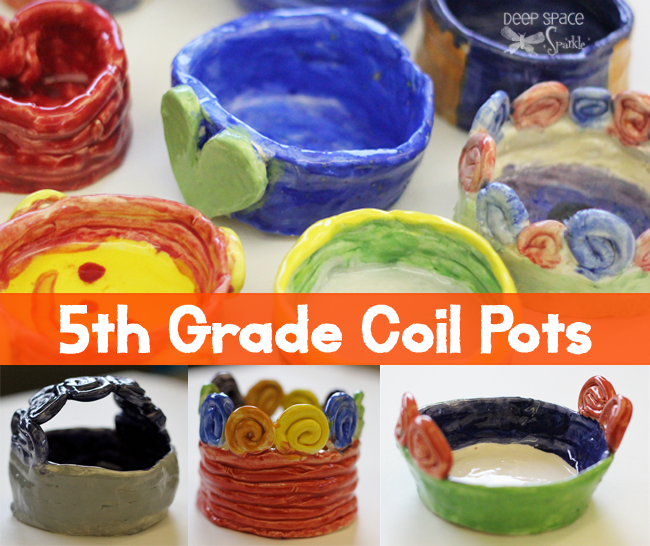
Clay Alternatives:
If you don’t have a kiln, you can do this project with air dry clay. I have only tried one brand and it was for an experiment in my e-course. Laguna air dry clay worked really well but the only problem was that it was very hard to manipulate. By adding some water to the clay block before hand, I softened the clay to make it more workable. Many art teachers have tried other brands and found that the creating of the pots worked out well, but the delicate pieces on the decorative coils broke off after drying. I would experiment with sealing the piece as quickly as possible and stressing to the kids to make their ropes thick.
Do you have any tips for coil pot newbies?
Learn how to Create with Clay projects with your k-3 students in the art room.
Want a free download to another Deep Space Sparkle ceramic lesson? Click the yellow download button below and we’ll send you a PDF lesson plan on how to make a ceramic snowman!













Have you tried to make these with oven-bake polymer clay? I’ve had success with small-scale pieces in white sculpey, though I have not tried coil pots.
No. My feeling is that Polymer clay is expensive and comes in very small packs, but I could be totally misguided. Also, I don’t have access to an oven at school.
Polymer clay is pricey. You could also use the air dry clay it’s better in price and no need to bake. Can be painted and altered just like regular clay. 🙂 They can build their pieces one day and paint the next.
Also paper clay, meant to say that before.
I just wanted to share a little tip that I leart for rolling ropes (I learnt this skill as a pastry chef and never thought I would need it as a teacher) When you roll out the ropes try to keep your fingers spread apart as wide as you can. This helps with the even sausage like shape and also stops it from breaking as some parts become much thinner than others. Try to encourage them to also not just roll back and forth in one place rather move your hands along the rope as well. Hope this is helpful.
We made coil pots with air dry clay. I would demo in one class period with everyone around a table, and the kids would each roll one snake, and add it to a ‘class pot’ as it passed around from kid to kid. In the next class, I posted the instructions for a reminder, put the tools and slip on the tables, and handed a ball of clay and a board to each student. If class ended before the student used up his ball of clay, he had to give back the leftovers. If he worked fast, he could come back for more clay, until we either ran out of time or out of clay. Next art class, we painted with school acrylic paints.
This is a really helpful suggestion for introducing clay to the kids and giving them time to warm up to the process and to the mess. I have two home-school classes and I try to keep them parallel to each other. I will be using your idea of how to space out this project. Thanks for contributing.
Did you have any difficulty with the weight of the decorative coils on top of the coil pot? I just made my own coil pot, but my pot started to bow and crack under the weight of the coils I added to the top…
No. The pots are pretty small, no bigger than a hand. The decorative coils are pretty light. The problem is applying the slip with a light enough touch that the decorations don’t fall off.
Hi Patty,
I am very frightened to do clay in my classroom as I only have 30 min/class each day. Mostly, I’m afraid because I have NEVER worked with it. I’m afraid I will get in over my head.
Is is possible to use the clay and just air dry it or do I have to put it in the kiln? I have several boxes of clay that were left in my room, but haven’t pulled them out yet.
Thanks much!
Michelle
Hi Michelle,
No,it’s not possible to use the clay without firing. It will crumble to bits. You can use a clay that is formulated for drying in the air. It’s called air dry clay.
If you have a kiln, you should give it a try. If you know anybody in you district who has used the kiln before, have him show you how to work the kiln an maybe offer some easy tips. I would start with a very simple pinch pot. Try it yourself first so you can work out your worries. It’s really just like working with play doh!
I had never taught clay before last year, and I was nervous about it too, but I loved it.
Today, as I was doing the first day of clay for the new year, I realized that for the class session, clay is actually easier clean-up than tempera paint! And the kids are so engaged that there really aren’t any behavior problems.
For your short class periods, I might recommend doing one session of “practice” with modeling clay. You can give instructions and let the kids try out the technique, and then the following week than can come in and get started right away with the real clay. I did that for my youngest classes last year. And because I was a beginner in teaching clay, I made my teaching mistakes on cheap reusable modeling clay instead of the good stuff!
You are so right. Clay is the absolute BEST. Great tips!
I’ve started using one class period as a demo day, I demo then let them work in pairs to make a practice piece together. Then I smoosh up the practice ones, or if they are good fire them for extras for those that break or kids who are absent. This has improved their speed and quasquaslity
Well, that’s just brilliant! Really great tip to share so thank you so much!
I am glad to see that I am no the one one to have some trouble with this project. I have done it for 3 years now. We don’t do the decorative additions, and instead of having the kids cut each coil and start a fresh rope, we continue and attach a new rope as we go. Some kids are good about smoothing the end down to pot, some leave it . The big problem is how some kids can’t get the clay to roll out without drying it out. I keep thinking I should make them put lots of lotion on because I feel like their little hands suck all the moisture out of the clay. I have 28 kids at a time. This year I tried doing a rotation, 9-10 kids at a time. It didn’t help much. Any pointers?
Try using a soda can wrapped with paper towel. Then start coiling around the can. This keeps it from sagging. By the way, I have 30 minute classes and have done ceramics for years. Not easy but doable. Just keep plenty of freezer bags with student names and teacher on each bag. I then house the bags in a Rubber mate type bin til next class. ( I only see the same students once every 5 days.)
I personally love working with clay have been including it in my K-5 curriculum for years. Here are some time saving tips that I hope others will find helpful.
Sometimes, especially in K-1 classes, I introduce clay just to ‘play’ with in one class period so the students have a feel for what the clay will and will not do with no pressure or expectations.It is important to constantly remind students that whatever they make will not be kept. I usually save coil pots for second or third graders and dedicate one class just for learning how to roll coils. This way, they are pretty savvy at rolling coils when we actually make our coil pots. After being very attentive to providing slip to students I have given in to the simplicity of plain old water. (I know a high school pottery teacher who insists that students simply spit on their clay instead of using slip. Yuk!). I found that if I can get students to score well and dab a bit of water on the joint they have equal success in having secure connections.
To provide more time for making their pots, and because I can rarely make out their writing, I have students write their name on a postcard size piece of newsprint or scrap paper and set their finished pot on top of it. I collect pots with paper and transfer their name to the bottom of the pot after school. This gives the clay a bit of time to harden a bit so it is easier to write the name clearly.
For more involved pieces, such as face jugs, I have them put their work in plastic bags (I inherited several boxes of bags from a previous art teacher) which have their names written on them with permanent marker. These will stay moist for weeks if necessary.
Speaking of keeping clay moist, If you place a wet cloth in the bag of leftover clay balls, they will stay moist a very long time which eliminates having to re-wet the clay.
Glaze is expensive and you never want to ruin it by having colors inadvertently mixed. After lots of experimenting, I have found a process that is simple and easy. I place a different color original container of glaze, with a small example of the fired color, on 8 tables (I have 10 tables so this leaves a couple open for early finishers.) There is a wet cloth on each table for wiping hands or bottoms of pots which eliminates trips to the sink and paper towel use. Each open jar has 3-4 brushes already in it. The process is: containers and brushes stay put and students travel. I usually limit the number of colors students can use depending on the size and complexity of the piece as well as the age of the students. If several students want the same color, all I have to do is provide more brushes. If there is a color no one wants it is simple enough to gather up the glaze and leave another table free for those early finishers to work on something else. So far, I have not had glaze contaminated with other colors and students enjoy being able to see each others’ work up close.
I love this blog!
Hi Patti…. looking at your directions on coil pots made under 50 min…. I see that you dont mention scoring… just using a brush to apply the slip and vinegar mixture… is this correct… you don’t need to score?
You’re correct, Cathi. The kids didn’t score. Sometimes when pieces are too small to score, slip is a great alternative to use to keep the clay pieces together. Of course, you could score and you could also smooth down the insides with a scraper to create a smooth interior. So lots of options.
And after the bowls are bisque fire, the application of the glaze keeps all the coils secure.
Hello Deep Space Sparkle community…I’m using generic air-dry clay this year. I had my 2nd graders ModPodge their pinch pots, but many of them just crumbled, so I’d like to try another varnish this time. Does anyone have any ideas? Also, can you tint it with paint? Thanks so much!
I used Laguna air dry clay and used Mod-Podge for glazing. It worked very well and the clay held up. Varnish won’t hold your piece together, so try switching clays instead of experimenting with the varnish.
This is my favorite go to spot! Thank you so much Patty!!I really like the suggestion about a class coil pot…for clay that will be fired in a kiln how should I store it?
Your lessons are always so awesome and helpful! This is my first year teaching and first time teaching clay on my own, but I feel much better after reading all your tips. Thank you! 🙂
Approximately how much clay would you purchase for one class? I am looking at purchasing clay for each grade level, and am unsure how far one 10-pound box of air dry clay will stretch in making pots and other small sculptures.
Hey Patty!
Can you explain your slip “recipe” in a bit more detail? What did you mean by “little bits of clay?”
l love it
love this idea !!
love this idea, can’t wait to try it out with my kids!!
this webs is good